
By John Beifuss on August 17, 2012 10:17 AM
Elvis loved his mother. Memphis filmmaker Mike McCarthy loved Elvis. He wanted to love his mother, too, but he didn't know her -- not his birth mother, that is.
This is a slightly longer version of a story that appeared Thursday (Aug. 16, the 35th anniversary of Elvis Presley's death) in The Commercial Appeal. The story was pegged to a screening at 7 that night of a film program titled "Tupelore" at the Memphis Brooks Museum of Art. The program included McCarthy's short Tupelo tourism film, "Tupelove," and his new autobiodocumentary, "Native Son."
TUPELO -- Unveiled last week in Elvis' hometown, the bronze statue of the King of Rock and Roll that now stands near City Hall is based on a world-famous photograph of Presley's "homecoming" performance at the Tupelo fair and dairy show.
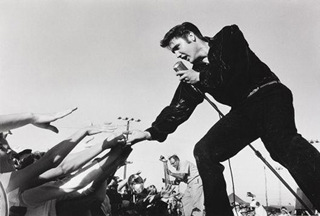
photo by Roger Marshutz
Shot on Sept. 26, 1956, by Roger Marshutz, the photo captures the black-clad singer in a sort of crouch, his right hand stretched before him, into the crowd of grasping, eager fans at the edge of the stage below. Reproduced in the statue, this gesture of greeting and acceptance has spanned the decades, and it has connected one mother and son in particular.
The brainchild of Memphis filmmaker Mike McCarthy, the Tupelo statue helped reunite McCarthy with the mother who gave him up for adoption when he was born 49 years ago -- a mother who was in the crowd at that very concert.
"I told her, 'You're the reason that statue exists,'" said McCarthy, who Aug. 16 at the Memphis Brooks Museum of Art debuted a long-in-production but swiftly completed hourlong documentary called "Native Son," about the statue, his Elvis fascination and his overdue family reunion. "I said, 'If I hadn't been so obsessed with finding you, then I wouldn't have thought that photo was so important."
"I told him his family completes me," said McCarthy's mother, Barbara Westmoreland Harris, 72, who operates a Tupelo popcorn business, the Caramel Corn Shop, with her husband, Titus. "There's been something missing that I didn't know about.
"Things were different 50 years ago when a girl was pregnant," Harris explained. "Now it's almost accepted. Then, it was a disgrace." Even so, "There was never a day that I didn't think about him," she said, referring to her absent son.
A musician and creator of comic books, music videos and highly personal independent films influenced by America's theoretically disposable but in fact indispensable "trash" culture, McCarthy has pursued his Elvis obsession through such experimental movies as "Elvis Meets the Beatles" (2000), produced by Craig Brewer; "Teenage Tupelo" (1995), a "fictional autobiography"; and "Damselvis, Daughter of Helvis" (1993), which featured such supporting characters as Rebelvis and Psychedelvis.
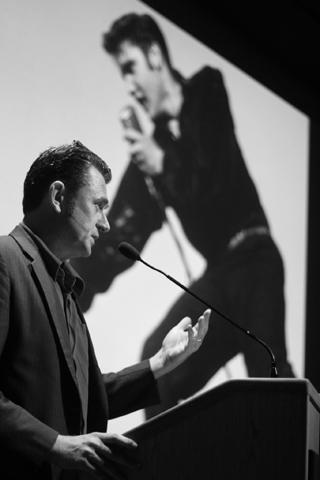
McCarthy introduces "Native Son" at Brooks Museum
photo by Daniel Lee Perea
"Even when I had a mohawk, I had sideburns," said McCarthy, who once developed a "religion" centered on Presley called "Gospelvis," inspired in part by "the walking paradox of Elvis, the gospel singer who moves like a stripper."
In what he calls a "prearranged private adoption," McCarthy -- born in Baldwyn, Mississippi, on "a rockabilly stretch of road" near Tupelo -- was accepted as a newborn baby by Mildred (who died in 1995) and John McCarthy (who died in 2010). The McCarthys raised the boy as their own on in the Jericho community of Northeast Mississippi, and did not tell him he was adopted.
Like McCarthy's biological mother, Mildred and John McCarthy were at the 1956 Elvis Tupelo concert. Whenever Mike McCarthy sees the Marshutz photograph reproduced on a purse or bag, he said, "I think they're toting around my family album."
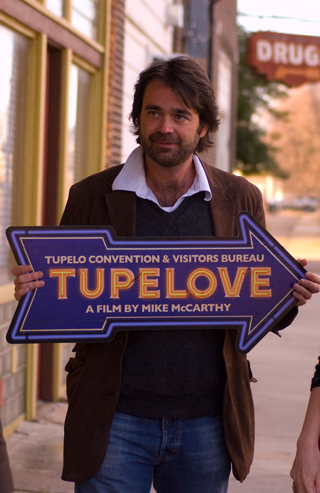
TUPELOVE producer Sean Johnson
photos and short film by Ronnie Harris
McCarthy learned he was adopted when he was 20, but he didn't pursue the identities of his birth parents for some time, in part because he didn't want to hurt the feelings of his beloved adoptive parents. Eventually, through various, sometimes accidentally dropped hints ("Everybody knew my secret except me") and the discovery of a brother (Ronnie Harris) he didn't know he had, he learned his birth mother's identity. What also floored him was his brother's revelation that his mother, at the age of 17, had been at the 1956 concert. Even so, McCarthy didn't approach Barbara Harris directly, although he sometimes went to the Tupelo mall and watched the popcorn shop, from a distance, out of curiosity. Mostly, "I bided my time and made art," he says.
The revelation of his mother's presence at the 1956 concert amplified McCarthy's Elvis obsession. He used to fantasize that Elvis was his father, a scenario that helped inspire "Teenage Tupelo," which he describes as "a meditation on the mother I never knew." He promoted the film with a reproduction of the Marshutz photograph, embellished with arrows connecting the hand of Elvis, labeled "father," to the hand of a woman, labeled "mother."
"I made it her hand in the picture because I needed that connection to some sort of past," McCarthy said.
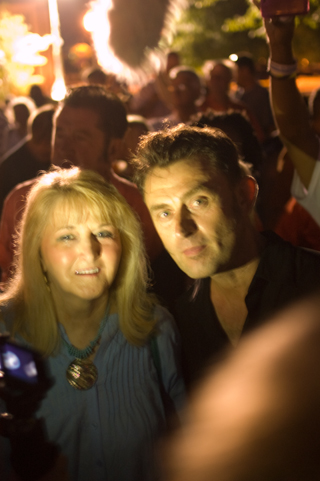
Barbara Harris and Mike McCarthy
McCarthy's mom only recently scuttled the filmmaker's Elvis-Is-My-Daddy dream. "Mike would love that, but that's not a real thing," said Harris, who won't reveal the identity of McCarthy's father, out of respect for her husband, she says. "I never slept with Elvis. I would have, probably, because he was a beautiful man. That's just the truth."
Although Harris saw Elvis in concert six times, the 1956 Tupelo show -- the performance was included in the $1.50 admission to the fair -- represented her closest encounter with the King, she said. "I was close enough that I could have touched him, but I didn't think that it was allowed. I don't remember crying, but I remember screaming. Just a typical girl at that time."
Said McCarthy: "The 'homecoming' show to me is the greatest rock-and-roll event of all time. It's Elvis coming back to Tupelo after seven years, leaving town with a family that couldn't be accepted and coming back as the king of popular culture. It's an amazing turn of events."
Last year, McCarthy was hired by the Tupelo Convention and Visitors Bureau to create a short film to promote Elvis tourism in the city where Presley was born. He cast Memphis actors Corey Parker and Amy LaVere as a visitor and a beautiful Mississippi ghost, and titled the film, not insignificantly, "Tupelove."
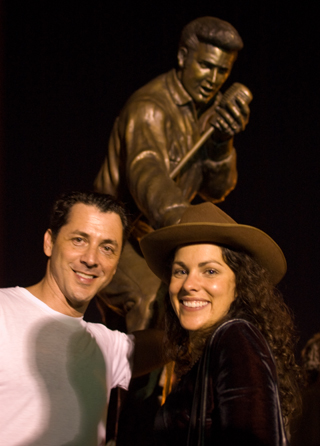
Actors Corey Parker and Amy LaVere
(who played "Norton" and "Vee" in TUPELOVE).
Sean Johnson, director of marketing for the Tupelo CVB, remembers brainstormings some ideas with McCarthy during a lunch in September, after the film project was in the works. Said Johnson: "Mike said, 'You know what would be really cool? If there was a statue... And it could be a statue of the Marshutz photo.'" Johnson was more than impressed with the idea: "It gave me chills when I thought about it."
Tupelo officials long had considered adding an Elvis statue to Fairpark, the public plaza space near City Hall, but hadn't pursued the idea seriously. The Marshutz concept, however, was too good to ignore.
Said Johnson: "Elvis was America in 1956 -- strong and young and innovative, all wrapped up into one beautiful thing."

Barbara 1959
With $50,000 provided by the CVB and another $25,000 raised in commemorative brick sales by the Tupelo Elvis Presley Fan Club, the statue was commissioned to artist Bill Beckwith of Taylor, Miss., and completed and erected in eight months -- an extraordinarily short period of time for such a project. "We positioned him so he's facing the birthplace," Johnson said.
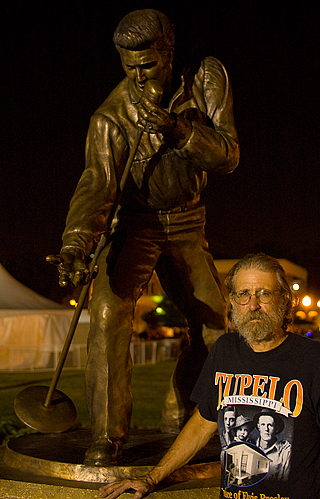
Sculptor Bill Beckwith
Beckwith also has created Mississippi statues of B.B. King, William Faulkner (sitting on a bench in Oxford), Jefferson Davis, Chickasaw Indian Chief Piomingo (also in Tupelo) and Jim Henson with Kermit the Frog. Beckwith said the bronze cast Elvis -- a somewhat larger-than-life creation that would stand seven feet if the King could straighten up, like Talos in "Jason and the Argonauts" -- likely will be scrutinized more closely than its predecessors.
"He was a huge responsibility," Beckwith said. "He's worshipped by so many people, with no sign of that subsiding. At the unveiling, I noticed people in their 60's, 70's maybe, with his portrait tattooed on their chest, and I thought, 'That's pretty intimate."
Beckwith refers to Elvis' outstretched arm as a "Sistine Chapel pose," akin to Michelangelo's famous God-gives-life-to-Adam mural; McCarthy, meanwhile, calls it a "superhero" gesture, as if Elvis were Captain Marvel Jr., reaching down to rescue the less fortunate. (Captain Marvel Jr., whose capes and signature lightning bolt perhaps inspired Elvis' later flamboyant costumes and "TCB" symbol, was a comic-book idol of Presley's childhood.)
McCarthy -- married with a wife, Kim, and two children, Hanna, now 13, and John Marvel, now 8 -- occasionally tried to contact his mother, resulting in "terse conversations," at best, he said. Harris was afraid to upset her established family, which included not just her husband and son Ronnie but another two grown sons, Chico and Rusty Harris. Said McCarthy: "Fear and love go hand in hand." His adoptive parents never told him his secret when he was younger, he said, because "they thought they would lose me if I knew the truth."
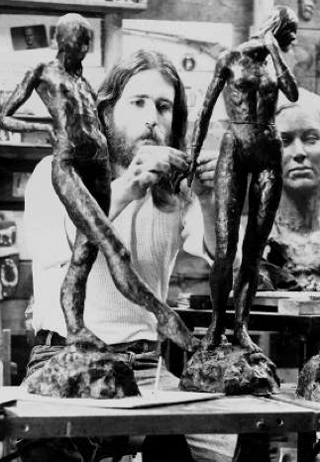
a young Bill Beckwith
The looming reality of the statue, however, imposed a sudden deadline and urgency to McCarthy's efforts, at least in the filmmaker's own mind. "I could not imagine Barbara, being the initial inspiration for the statue, not being at the unveiling, and me not knowing her," he said.
Lured in part by the possibility of meeting two more young grandchildren, and encouraged by other relatives (in the age of Facebook friends, it's hard to remain estranged), Harris gradually, warily let down her guard. As the statue was evolving, "so was the relationship with my newfound mother," says McCarthy. (He finds her livelihood especially appropriate: "I make movies, she makes popcorn.")
The timelines were almost parallel, with Beckwith bringing Elvis to life and Harris allowing herself to be exposed -- unveiled, if you will -- to her lost son and his family. A meeting in May represented the first real thaw, and by August, the Harris' and McCarthys not only knew each other but had become united, to some extent, as one awkward, extended, all-American, Elvis-loving family.
Harris, for her part, is reluctant to accept any credit for the Elvis statue, which was unveiled August 9 in an elaborate ceremony, at which she and McCarthy were just two of the several thousand observers in the crowd. "I've not had any spectacular life," she said. "I've not had any claim to fame, so to speak, except for having these boys, who are so talented."
But McCarthy insists that life and art -- like fear and love -- walk hand in hand; and he considers the statue, with its own welcoming hand, to be an "interactive" work of art. After Elvis was unveiled, he said, he found himself with Harris. "My mother and I were at the hand, touching it together."
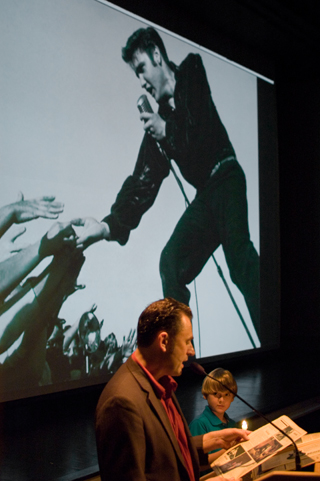
McCarthy at Brooks Museum with son John Marvel
copyright 1988, 2012 by Mike McCarthy
Page design Ronnie Harris
